Turtle Townies
Since they are such a quiet clan, we tend to forget the chelonian inhabitants of our town. Sharon is home to six species of turtle: snapping turtles, spotted turtles, Blandings turtles, painted turtles, box turtles, and mud turtles (aka musk turtles). Some are more visible than others.
The basic blueprint of turtles is as follows: The shell, called the carapace, is actually made of 50 or so bones. It is in essence the skeleton, spine, and ribs grown on the outside of the turtle. Like bones, the shell can heal if damaged. The individual plates we see are called scutes, the Latin word for shield. The bottom of the turtle is the plastron, after the Greek for plastered or daubed on. The band of small plates around the lower edge of the shell, joining top and bottom like the crimped edge of a pie, is called the bridge.
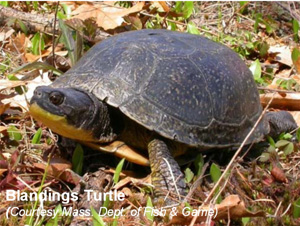 Blandings turtle (Emydoidea
blandingii) is sometimes
referred to as a semi-box turtle. The shell is domed in profile.
Unlike a true box turtle, Blandings is aquatic and a very good swimmer.
He is a timid turtle, about 7–9 inches long. The best identifier
is the bright yellow on the chin and neck. The Blandings turtle is
listed as threatened on the Massachusetts Endangered Species List,
mainly because roads and development have fragmented its habitat
and predators have threatened its eggs. Blandings turtles can live
for eighty years.
Blandings turtle (Emydoidea
blandingii) is sometimes
referred to as a semi-box turtle. The shell is domed in profile.
Unlike a true box turtle, Blandings is aquatic and a very good swimmer.
He is a timid turtle, about 7–9 inches long. The best identifier
is the bright yellow on the chin and neck. The Blandings turtle is
listed as threatened on the Massachusetts Endangered Species List,
mainly because roads and development have fragmented its habitat
and predators have threatened its eggs. Blandings turtles can live
for eighty years.
Eastern box turtle (Terrapene carolina carolina) is a terrestrial
turtle. They can be found in mixed forest grasslands and swamps.
They do sometimes venture into water, but this seems to be only for
bathing purposes or to escape heat. Sometimes they bury themselves
in mud. In cold times, box turtles may dig themselves into the ground--as
much as two feet deep. Box turtles are omnivores, eating insects,
berries, and leaves, and sometimes scavenging. Unique to the box
turtle is its ability to pull entirely into its shell. Hinged sections
in front and back of the plastron shut, effectively converting the
turtle into a rock. Box turtles are homebodies, usually not straying
beyond a territory 200 yards in diameter.
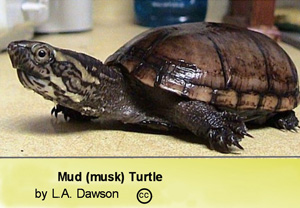 Mud turtle (Sternotherus
odoratus) is also known as the musk turtle or “stinkpot.” They
range from 3 to 5 inches in length and are a grey or brown color.
They release a bad-smelling, musky odor if disturbed. These turtles
are almost entirely aquatic, although they can sometimes be seen
sunning on rocks or logs. So, while very common in Sharon, they are
seldom seen, as they remain in the depths. They are carnivorous.
An interesting feature is the buds on their tongues. These papillae
or tiny projections allow the mud turtle to breathe underwater to
some extent by absorbing oxygen. This is the secret of their almost
entirely submerged existence.
Mud turtle (Sternotherus
odoratus) is also known as the musk turtle or “stinkpot.” They
range from 3 to 5 inches in length and are a grey or brown color.
They release a bad-smelling, musky odor if disturbed. These turtles
are almost entirely aquatic, although they can sometimes be seen
sunning on rocks or logs. So, while very common in Sharon, they are
seldom seen, as they remain in the depths. They are carnivorous.
An interesting feature is the buds on their tongues. These papillae
or tiny projections allow the mud turtle to breathe underwater to
some extent by absorbing oxygen. This is the secret of their almost
entirely submerged existence.
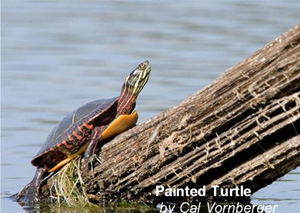 Eastern painted turtle (Chrysemys
picta)
This turtle is 4–10 inches long and probably the most commonly seen
In Sharon as they come out to bask on logs and rocks. Their shells
are olive black and yellow on the bottom. Painted turtles derive
their name from the red and yellow stripes on their neck, legs, and
tail. They also have red dots ringing the lower edge of the bridge
(rim) of their shell. These creatures are very common throughout
North America and Canada. There are four subspecies. The painted
turtle can withstand cold better than other turtles. They have been
seen swimming under ice. It is thought that they moved northward
around 11,000 years ago after the Ice Age as the glaciers retreated.
Fossils indicate that these turtles have not changed greatly for
15 million years.
Eastern painted turtle (Chrysemys
picta)
This turtle is 4–10 inches long and probably the most commonly seen
In Sharon as they come out to bask on logs and rocks. Their shells
are olive black and yellow on the bottom. Painted turtles derive
their name from the red and yellow stripes on their neck, legs, and
tail. They also have red dots ringing the lower edge of the bridge
(rim) of their shell. These creatures are very common throughout
North America and Canada. There are four subspecies. The painted
turtle can withstand cold better than other turtles. They have been
seen swimming under ice. It is thought that they moved northward
around 11,000 years ago after the Ice Age as the glaciers retreated.
Fossils indicate that these turtles have not changed greatly for
15 million years.
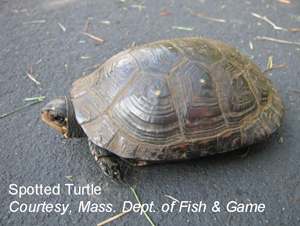 Spotted turtle (Clemmys
guttata) This small 3–5-inch-long
turtle is semi-aquatic. It likes wet places such as bogs, flooded
forests, and marshes. Its shell is bluish black and has yellow
spots. The number of spots tends to increase with age. These turtles
live about 25 years; however, some may live to 50. The male has
a tan-colored chin, while the female’s chin is yellow. Females
grow larger than males and average more spots. Males have brown
eyes and females orange. While, not threatened or endangered, spotted
turtles are listed as “of concern” in some states.
Spotted turtle (Clemmys
guttata) This small 3–5-inch-long
turtle is semi-aquatic. It likes wet places such as bogs, flooded
forests, and marshes. Its shell is bluish black and has yellow
spots. The number of spots tends to increase with age. These turtles
live about 25 years; however, some may live to 50. The male has
a tan-colored chin, while the female’s chin is yellow. Females
grow larger than males and average more spots. Males have brown
eyes and females orange. While, not threatened or endangered, spotted
turtles are listed as “of concern” in some states.
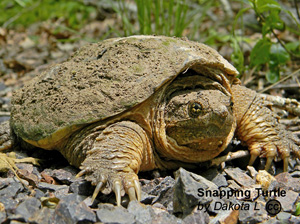 Snapping turtle (Chelydra
serpentina) These are large turtles and may grow to a
shell length of 20 inches. Out of water they exhibit a belligerent
personality. In the water they usually retreat from any threat.
The snapping turtle, as its Latin name implies, has a long, snake-like
neck. Acting like a snorkel, it allows them to breathe when they
are lying underwater. It also makes it dangerous to pick them up,
as they can reach far around and bite even when held by the sides.
Unlike other turtles, the snapping turtle cannot retreat far into
its shell, so it’s forced to use its bite as a defense. Lore has
it that a snapping turtle can chomp a broomstick in half. This
is not true—unless it is very soft broomstick! But make no mistake,
they can sever a finger!
Snapping turtle (Chelydra
serpentina) These are large turtles and may grow to a
shell length of 20 inches. Out of water they exhibit a belligerent
personality. In the water they usually retreat from any threat.
The snapping turtle, as its Latin name implies, has a long, snake-like
neck. Acting like a snorkel, it allows them to breathe when they
are lying underwater. It also makes it dangerous to pick them up,
as they can reach far around and bite even when held by the sides.
Unlike other turtles, the snapping turtle cannot retreat far into
its shell, so it’s forced to use its bite as a defense. Lore has
it that a snapping turtle can chomp a broomstick in half. This
is not true—unless it is very soft broomstick! But make no mistake,
they can sever a finger!
Our Sharon snappers should not be confused with the southern alligator
snapping turtle, (macrochelys temminckii), which can weigh as much
as 75 pounds (one was reported at 405 pounds) and grow to 36 inches
or more. These are true battle-wagon turtles. Our New England snappers
probably enjoy some of their fierce reputation based on the reputation
of their southern cousins.
Snapping turtles are omnivorous. Very omnivorous! One interesting fact is that once laid, their eggs can hatch as long as a year later, triggered by the suitability of temperature. Snapping turtles are also very particular about the places they lay eggs. They seek out historical places, preferring loose sandy soil. They have been known to scale fences and invade yards to find their traditional nesting spots.
```````````````````````````
Human infrastructure and activities are a major threat to turtles.
See this snapping
turtle drama in pictures.
When driving, especially in spring, please keep an eye out for turtles. If you find an injured turtle, you should seek help from a licensed wildlife rehabilitator. Probably most convenient for Sharon is New England Wildlife Center in Weymouth: 500 Columbian St., South Weymouth, 781-682-4878. Other wildlife rehabilitators are also available.
Back to Items of Interest
